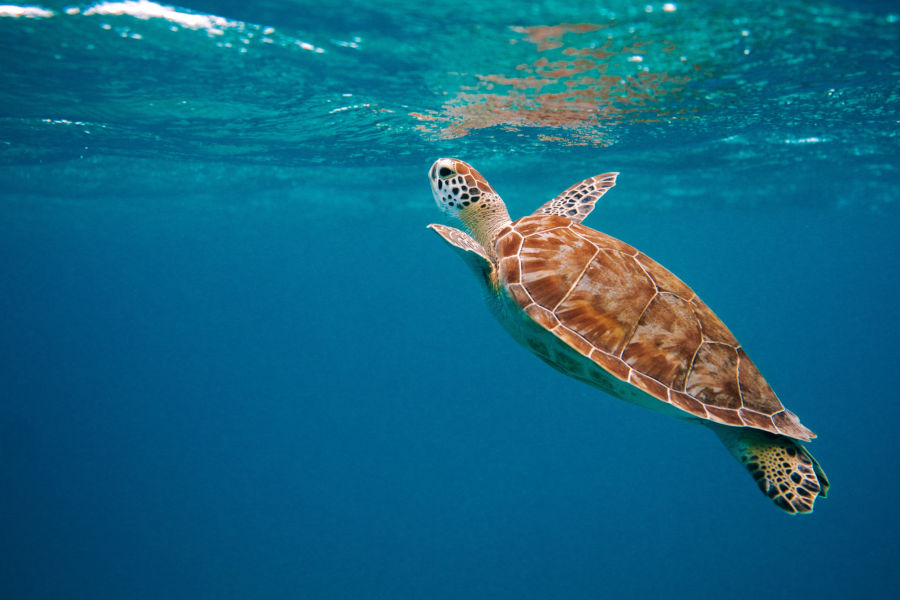The Gilis are known for their large number of sea turtles on the surrounding reefs and have even been dubbed, ‘Turtle capitol of the world’. A name that’s definitely not wasted on this group of islands! You are basically guaranteed an encounter with at least one of these magnificent sea creatures whether you go snorkeling or diving.
Turtles are very stable and have been around forever. But they have problems adapting. When humans came along, turtles came under serious threat.
“
Turtles are very stable and have been around forever. But they have problems adapting. When humans came along, turtles came under serious threat.
The Turtles of the Gilis
You’ll find two different species of turtles roaming the azure waters around the islands, green turtles and hawksbill turtles. You can easily tell them apart as they are rather different in appearance. Green turtles, first of all, have a more rounded shell which is usually kept very clean. Yes, they actually groom themselves! Second, they have a more rounded snout than their counterparts. The Hawksbill actually derives its name from the birdlike beak they have. Their shells are also more jagged and often covered in barnacles and sea moss.
Green turtles live mostly on a diet of seagrass with which they play an important role in keeping the eco system healthy and functioning. Healthy seagrass provides for an excellent nursery for many fish species while at the same time it protects the coastal areas from storms.
Hawksbills prefer using their ‘beaks’ to scrape the algae of reefs which also in turn helps the reefs to stay healthy. Both species, each in their own way, perform a very important role in the reef eco systems. Protecting and cultivating them is a must.
Unfortunately, both of them are on the list of endangered species, hawksbills even as critically endangered. However, on the Gili Islands the world is still a little bit more in order as both species seem to thrive there. The question is, why do they thrive on the Gilis and struggle elsewhere around the world?
Why is there so many turtles?
We may find part of the answer with the local population itself. About 200 years ago, fishermen from Sulawesi arrived on the Gili Islands. They began to form temporary settlements because of the abundance of fish in the surrounding sea and also the presence of fresh water on Gili Air. After a while they chose to stay there and the current population consists of mainly their descendants and some ‘fresh’ arrivals from Lombok itself.
Fortunately for the turtles, the local population that now inhabits the islands, unlike their Balinese neighbors, didn’t develop a taste for turtle meat. So, they have been mostly left alone.
Also, throughout the years multiple efforts have been made to stimulate their numbers around the islands by means of turtle sanctuaries. One such sanctuaries is currently on Gili Meno where a team of dedicated people works to ensure the Gili turtle population stays healthy. They hatch around 500 eggs per year and only release the ‘turtle babies’ once they’re a few months to one year old. Turtle releases take place every few months. You can be part of a release which involves a small fee which is donated back to the turtle sanctuary.
Growing them to a certain size gives them a much better chance for survival. In the wild usually only one in a 1000 survives to reach adulthood. As these odds seem staggering, it’s all part of nature’s design as every year when the turtle eggs hatch they provide many other species with a necessary supply of food. Many fish, birds, lizards feed on the hatchlings and as brutal as this may seem, it all plays a role in nature’s never-ending circle of life. Once they manage to reach a certain size they’re more or less safe from most predators. Although tiger sharks do have a taste for grown turtles and the jaws to deal with them. Fortunately for the turtles but maybe unfortunately for the divers, we don’t think tiger sharks have ever been spotted around the Gili Islands.
The Sanctuary
The Gili Meno Turtle Sanctuary is located on the south-east beach of Gili Meno, just a short walk on the beach from the main jetty. When you get off the jetty just turn left.
It’s easy to find the hut and its numerous pools with turtles in different stages of their ‘young’ lives. The sanctuary is usually open to visitors seven days a week from 9am to 9pm. Well worth a visit and the staff there are more than happy to answer any questions you have about these awesome marine creatures.
Don’t forget, they rely heavily on donations to keep their project afloat so they will be very happy with anything you can spare. Whatever you give, it’s a really small price to pay for helping ensure the Gilis stay the turtle capitol of the world.







